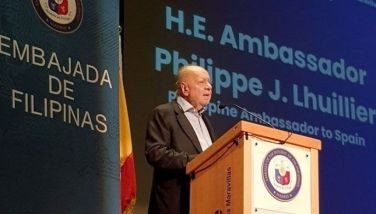A season of a thousand faces in the global city for the arts
July 3, 2006 | 12:00am
 I saw this quote by artist Hartwig Ebersbach at the Singapore National Museum: "There is no future without memory, maybe no fire either." No future also without creativity. Maybe there would still be, although in a Blade Runner or Brazil sense I suppose. But who wants to live in a future of dead and dreary concrete cityscapes inhabited by a blank generation, and where art is dead and emptiness is forever? Not you. Definitely not me.
I saw this quote by artist Hartwig Ebersbach at the Singapore National Museum: "There is no future without memory, maybe no fire either." No future also without creativity. Maybe there would still be, although in a Blade Runner or Brazil sense I suppose. But who wants to live in a future of dead and dreary concrete cityscapes inhabited by a blank generation, and where art is dead and emptiness is forever? Not you. Definitely not me.
The Singapore Tourism Board (STB) recently invited The Philippine STAR to see the flowering of creativity in the Lion City during the Singapore Arts Festival. Spearheading the series of events is the National Arts Council (NAC), which was set up as a statutory board in September 1991 to oversee the development of the arts in Singapore. Its mission is "to nurture the arts and make it an integral part of people’s lives in Singapore."
In line with this, the NAC adopts strategies to nurture artistic talent and promote the practice and appreciation of the arts among Singaporeans. The NAC is in charge of putting up events and festivals such as the Singapore Art Show, the Singapore Biennale (a highly anticipated event to be held in September this year), the Singapore Writers Festival, the Noise Festival and, of course, the Singapore Arts Festival.
"The heart of the festival is about encouraging and supporting artists and their instincts to dream and roam creatively, and seeking to connect their works with Singapore audiences," says Singapore Arts Festival director Goh Ching Lee. "Through the commissioning of new works and championing artistic collaborations of Singapore and Asian artists, introducing fresh creative insights and presenting works of international artists of the highest caliber, the festival this year (has brought) a strong sense of energy, discovery and adventure."
As in last year’s festival, artists from all over the world came together from June 1 to 25 to showcases their creations, which were captivatingly quirky and quirkily captivating.
Dig this: visiting Singapore during the three-and-a-half-week festival was like stumbling mind-first into a hallucinogenic Tom Robbins novel.
An Austrian ensemble played music with vegetables by way of special microphones that amplified the sounds of potatoes, tomatoes, celery stalks and broccolis. I wonder if the Vegetable Orchestra performed Green, Green Grass of Home. Sound effects artists from Australia staged a play inspired by Alfred Hitchcock’s Vertigo, using eggbeaters, ice in glass, and windscreen wipers, among other objects to conjure an archetypal tale of love and menace in Phobia by the Chamber Made Orchestra. A theater troupe interpreted Anton Chekov plays by using live cartooning and drawing in Samovar – Check Out Chekov by Schauspielhaus Vienna. Three plasticine characters from a Singaporean group called Zephydom interacted and engaged viewers as living sculptures. A marionette called Bruno the Clown did amazing skits with his, uh, pants which went by the name Boney in String Fling by Mascots and Puppets Specialists from Singapore. (Hmmm, I wonder if Bruno’s pants also wore pants.) In 160 Characters, Vanilla Productions from Australia asked its viewers to forward their most intriguing text messages to an onstage phone, and each message inspired an improvised comedic sketch.
Aside from those offbeat performances, there were also the more conventional but not less enlightening productions by Victoria Hanna and the Israeli Contemporary String Quartet, Nederlands Dans Theater I, the Camerata Salzburg, and the Philharmonic Winds from Singapore, among other performers. Virtuosos John Williams and Richard Harvey also astounded audiences with two guitars, 12 strings and the truth.
And the truth is, this year’s roster of performances is more riveting and mind-altering than last year’s.
Staged at the Victoria Theater, body_remix/gOLDBERG_variations takes people’s preconceived notions about ballet and bodies in motion and tweaked with them – remixed them, if you will. Imagine men and women (with bodies that look as if they were sculpted by the hands of Rodin) with crutches, canes, points, prosthetics, and harnesses interpreting Bach’s Goldberg Variations (performed by Glenn Gould in ’81) that has been "transformed, decomposed, recomposed and remixed."
The soundtrack is not unlike a classical record being spun and re-spun infinitely by a godlike DJ combined with voiceover snatches that recall the voice of Stephen Hawking: "I’ve been sitting here squirming in my chair, as you know, wishing I’d never said a word on the subject!" The dancers – disabled by the iron contraptions – interpret the cut-up music by doing cut-up movements which were sometimes painful to watch but always graceful to behold. This left most of the viewers almost squirming in their seats.
Chouinard said she undertook a kind of remix of the dancers’ bodies through the use of the aforementioned supports (canes and crutches, etc.), creating movements of "calculated distortions and beguiling beauty."
It was like watching Francis Bacon’s screaming popes or contorted loners trying to dance across the canvas to the distorted music of Bach. It was queasily beautiful (if such a phrase exists). Grace garbled beyond belief. The props also reminded me of those strange, metal implements used in an operation in one of the scenes in David Cronenberg’s Dead Ringers. (The flick features Jeremy Irons playing a pair of twins.) Yes, there is something weirdly clinical about Chouinard’s ballet.
One of the journalists, Vincent O’Donnell, remarked that bODY_remix is a sort of commentary on grace and disability. Australian curator Sarah Miller said the dance is all about the crippling effects of dancing, something to do with those cruel pointe shoes used in ballet. Imogen Neal, a radio host from New Zealand, said in the end you don’t see dancers onstage (or people for that matter), but purely anatomical structures. Bodies, merely. Bodies, as Johnny Rotten once sang.
For me, the most remarkable thing about the whole production is that even if the bODY_remix dancers are burdened by those metal appendages, they create a sort of freedom of movement never achieved by dancers without harnesses. The dance is a meditation on the architecture of the human body, and how it transcends restrictions and limitations. What all great art is about.
The Great War at the Esplanade Theater Studio features – I am not making this up – toy soldiers, miniature tanks, paper cutout steamboats, and model cities.
Dig the conceit: the performers create "live" actions in front of the audience with beans, mud, smoke, bombs, brushes, parsley and toy soldiers to construct and manipulate miniature battlefields and conjure a world at war.
Curiously, it was like watching adults play tau-tauhan. With a twist, of course.
Remember when you were a kid playing with your G.I. Joe action figures, digging trenches in the backyard, creating barracks of shoeboxes and discarded Tupperware bowls, and concocting elaborate battles – a backyard Armageddon? Hotel Modern has taken this to the level of theater by filming the World War I battle scenes and then projecting them onto a movie screen. Visual artist and performer Herman Helle, together with actors Pauline Kalker and Arléne Hoornweg, use mini-cameras that run through the trenches and peek over the top of the warscape.
Rain, smoke, mustard gas attacks and dead comrades are the some of the elements of The Great War narrative, reminiscent of All Quiet On The Western Front and Dalton Trumbo’s Johnny’s Got His Gun). (A side note: Trumbo’s novel featuring a soldier who loses all of his limbs during a bomb blast inspired Metallica’s One.)
In The Great War, there is a live narration of soldiers’ riveting letters. There is a sound concept man (Arthur Sauer) who uses everything from a high-tech samplers to a low-tech vibrator vibrating over a plate of marbles. (The vibrator, he disclaimed, is used primarily for that purpose only, not for anything kinky.) And there are the performers with handy flamethrowers generating a mini apocalypse on the hapless miniatures. We in the theater could practically smell the scorched earth.
War is hell, all right.
So is leaving one’s family to work in a strange land.
The Necessary Stage’s Mobile at the Drama Center Theater deals with stories of women and men who are affected by labor migration – the sex workers, the construction workers, and the maids. It involves a unique collaboration involving artists from Singapore, Thailand, and Japan, including our very own Mailes Kanapi (from Tanghalang Pilipino) and Rody Vera (who was the artistic director of The Philippine Educational Theater Association). Great performances by two Filipino actors.
The play – which involves co-director Alvin Tan, co-director/writer Tatsuo Kaneshita, and head writer Haresh Sharma – centers on foreign workers and their modern-day diaspora. As such, it presents seemingly stereotypical characters (a hooker with a heart of gold, a Japanese businessman who frequents karaoke bars) caught in a web of interwoven stories. "Travels and journeys are more than just literal," according to Tan. "But how deeply aware are we of what we give up when we move?
As the world becomes more mobile, has it also become more foreign? That is the question.
The artists featured in an exhibit titled "The Scenic Eye: Visual Arts and the Theater," on view until July 23 at the National Museum of Singapore poses different questions.
Rosemarie Trockel nitpicks on the importance of wearing clothes. Jochen Gerz makes the viewer the producer of the artwork, a collaborator in a video installation work. And Hartwig Ebersbach – who created a three-part picture wall titled "Orpheus" – wants to look back on what was gone and lost, and wants to move forward from there.
"There is no future without memory, maybe no fire either," said Ebersbach.
Maybe no dreams also. Great thing about the Singapore Arts Festival is that it continues in assisting artists all over the world to "dream and roam creatively."
BrandSpace Articles
<
>



















